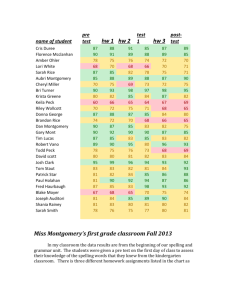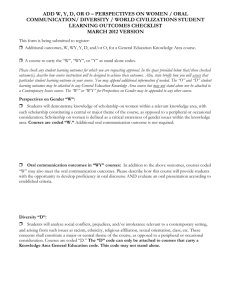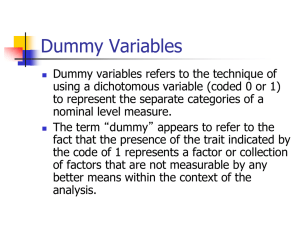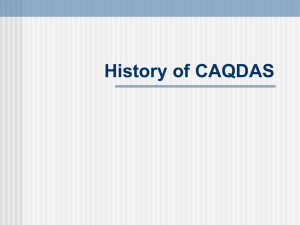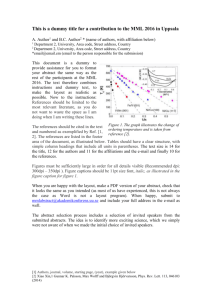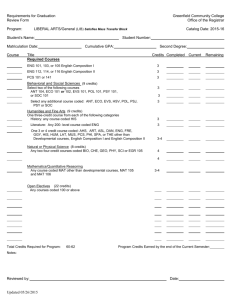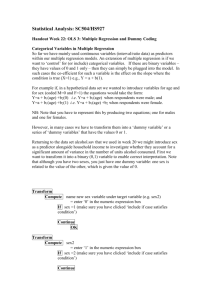Code book for Pollins` data - The University of Texas at Dallas
advertisement
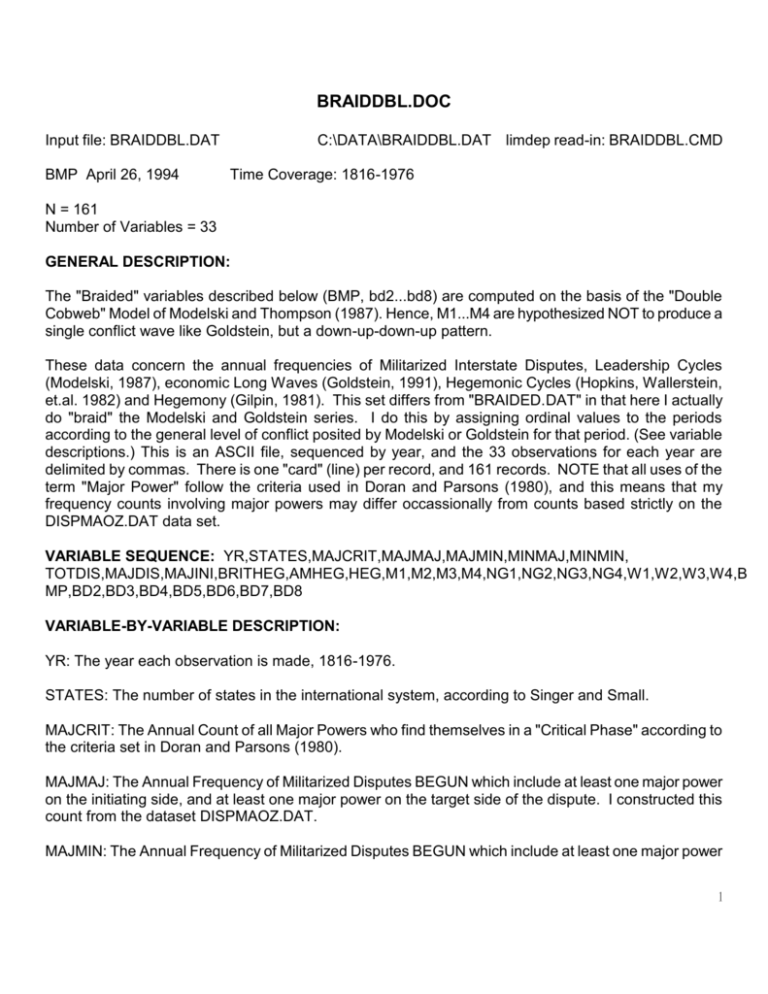
BRAIDDBL.DOC Input file: BRAIDDBL.DAT BMP April 26, 1994 C:\DATA\BRAIDDBL.DAT limdep read-in: BRAIDDBL.CMD Time Coverage: 1816-1976 N = 161 Number of Variables = 33 GENERAL DESCRIPTION: The "Braided" variables described below (BMP, bd2...bd8) are computed on the basis of the "Double Cobweb" Model of Modelski and Thompson (1987). Hence, M1...M4 are hypothesized NOT to produce a single conflict wave like Goldstein, but a down-up-down-up pattern. These data concern the annual frequencies of Militarized Interstate Disputes, Leadership Cycles (Modelski, 1987), economic Long Waves (Goldstein, 1991), Hegemonic Cycles (Hopkins, Wallerstein, et.al. 1982) and Hegemony (Gilpin, 1981). This set differs from "BRAIDED.DAT" in that here I actually do "braid" the Modelski and Goldstein series. I do this by assigning ordinal values to the periods according to the general level of conflict posited by Modelski or Goldstein for that period. (See variable descriptions.) This is an ASCII file, sequenced by year, and the 33 observations for each year are delimited by commas. There is one "card" (line) per record, and 161 records. NOTE that all uses of the term "Major Power" follow the criteria used in Doran and Parsons (1980), and this means that my frequency counts involving major powers may differ occassionally from counts based strictly on the DISPMAOZ.DAT data set. VARIABLE SEQUENCE: YR,STATES,MAJCRIT,MAJMAJ,MAJMIN,MINMAJ,MINMIN, TOTDIS,MAJDIS,MAJINI,BRITHEG,AMHEG,HEG,M1,M2,M3,M4,NG1,NG2,NG3,NG4,W1,W2,W3,W4,B MP,BD2,BD3,BD4,BD5,BD6,BD7,BD8 VARIABLE-BY-VARIABLE DESCRIPTION: YR: The year each observation is made, 1816-1976. STATES: The number of states in the international system, according to Singer and Small. MAJCRIT: The Annual Count of all Major Powers who find themselves in a "Critical Phase" according to the criteria set in Doran and Parsons (1980). MAJMAJ: The Annual Frequency of Militarized Disputes BEGUN which include at least one major power on the initiating side, and at least one major power on the target side of the dispute. I constructed this count from the dataset DISPMAOZ.DAT. MAJMIN: The Annual Frequency of Militarized Disputes BEGUN which include at least one major power on the initiating side, and NO major powers on the target side of the dispute. I constructed this count from the dataset DISPMAOZ.DAT. MINMAJ: The Annual Frequency of Militarized Disputes BEGUN which include NO major powers on the initiating side, and at least one major power on the target side of the dispute. I constructed this count from the dataset DISPMAOZ.DAT. MINMIN: The Annual Frequency of Militarized Disputes BEGUN which include NO major powers on the initiating side or on the target side of the dispute. I constructed this count from the dataset DISPMAOZ.DAT. TOTDIS: The Annual Frequency of Militarized Disputes BEGUN in the international system. This is simply the sum of MAJMAJ + MAJMIN + MINMAJ + MINMIN. By extension, therefore, I constructed this count from the dataset DISPMAOZ.DAT. MAJDIS: The Annual Frequency of Militarized Disputes BEGUN which include at least one major power on the initiating side or on the target side. This is simply the sum of MAJMAJ + MAJMIN + MINMAJ. By extension, therefore, I constructed this count from the dataset DISPMAOZ.DAT. MAJINI: The Annual Frequency of Militarized Disputes BEGUN which include at least one major power on the initiating side. This is simply the sum of MAJMAJ + MAJMIN. By extension, therefore, I constructed this count from the dataset DISPMAOZ.DAT. BRITHEG: Dummy Variable coded 1 for years in which Britain is considered a Hegemon, according to Wallerstein (1984) and Gilpin (1981), and 0 otherwise. These two authors list exactly the same years, according to Boswell and Sweat (1991). Britain is considered a hegemon between 1814 and 1873. AMHEG: Same for American Hegemony. All the same comments apply. The U.S. is considered a hegemon from 1945 to 1967. HEG: Dummy variable to code presence of hegemon in the system. i.e. 1814-1873 and 1945-1967. M1: Dummy Variable coded 1 for years identified as "World Power" phase by Modelski (1987), and 0 otherwise. M2: Dummy Variable coded 1 for years identified as "Delegitimation" phase by Modelski (1987), and 0 otherwise. M3: Dummy Variable coded 1 for years identified as "Deconcentration" phase by Modelski (1987), and 0 otherwise. M4: Dummy Variable coded 1 for years identified as "Global War" phase by Modelski (1987), and 0 otherwise. NG1: Dummy Variable coded 1 for years identified as "Expansion" phase by Goldstein (1991), and 0 otherwise. NG2: Dummy Variable coded 1 for years identified as "Stagflation/War" phase by Goldstein (1991), and 0 otherwise. NG3: Dummy Variable coded 1 for years identified as "Stagnation" phase by Goldstein (1991), and 0 otherwise. NG4: Dummy Variable coded 1 for years identified as "Rebirth" phase by Goldstein (1991), and 0 otherwise. W1: Dummy Variable coded 1 for years identified as "Victory" phase by Hopkins, Wallerstein, et.al. (1982), and 0 otherwise. W2: Dummy Variable coded 1 for years identified as "Maturity" phase by Hopkins, Wallerstein, et.al. (1982), and 0 otherwise. W3: Dummy Variable coded 1 for years identified as "Declining" phase by Hopkins, Wallerstein, et.al. (1982), and 0 otherwise. W4: Dummy Variable coded 1 for years identified as "Ascending" phase by Hopkins, Wallerstein, et.al. (1982), and 0 otherwise. BMP: Simple addding of the "conflict values" I assigned to the two waves. For Goldstein, NG3=Stagnation=Conflict Value 1; NG4=Rebirth=Conflict Value 2; NG1=Expansion=Conflict Value 3; NG2=Stagnation/War=Conflict Value 4. For Modelski, M1=World Power=Conflict Value 1; M2=Delegitimation=Conflict Value 3; M3=Deconcentration=Conflict Value 2; M4=Global War=Conflict Value 4. Note the differences in the conflict-generating dynamics. Goldstein is relatively continuous over the life of one cycle, Modelski's goes down-up-down-up. BD2: Dummy Variable coded 1 when both cycles are at a low point (e.g. Stagnation for Goldstein, World Power for Modelski). Coded 0 otherwise. BD3: Dummy Variable coded 1 when the combined conflict values of the two cycles = 3. Coded 0 otherwise. BD4: Dummy Variable coded 1 when the combined conflict values of the two cycles = 4. Coded 0 otherwise. BD5: Dummy Variable coded 1 when the combined conflict values of the two cycles = 5. Coded 0 otherwise. BD6: Dummy Variable coded 1 when the combined conflict values of the two cycles = 6. Coded 0 otherwise. BD7: Dummy Variable coded 1 when the combined conflict values of the two cycles = 7. Coded 0 otherwise. BD8: Dummy Variable coded 1 when the combined conflict values of the two cycles = 8. Coded 0 otherwise. REFERENCES Boswell, Terry, and Mike Sweat (1991) "Hegemony, Long Waves, and Major Wars: A Time Series Analysis of Systemic Dynamics 1496-1967," International Studies Quarterly, v.35, no.2 (June) pp.123149. Doran, Charles, and Wes Parsons (1980) "War and the Cycle of Relative Power," American Political Science Review, v.74, no.4 (December) pp.947-965. Gilpin, Robert (1981) War and Change in World Politics (Cambridge: Cambridge University Press.) Goldstein, Joshua S. (1991) "A War-Economy Theory of the Long Wave" in Niels Thygesen, Kumaraswamy Velupillai and Stefano Zambelli (eds.) Business Cycles: Theories, Evidence and Analysis (London: Macmillan) pp.303-325. Hopkins, Terence K. and Immanuel Wallerstein, et.al. (1982) "Cyclical Rhythms and Trends of the Capitalist World-Economy" in Terence K. Hopkins, Immanuel Wallerstein et.al. (eds.) World-System Analysis: Theory and Methodology (Beverly Hills: Sage Publications) Modelski, George (1987) Long Cycles in World Politics (Seattle: University of Washington Press.) Modelski, George and William R. Thompson (1987) "Testing Cobweb Models of the Long Cycle" in George Modelski (ed.) Exploring Long Cycles (Boulder,CO: Lynn Rienner Publlishers) Wallerstein, Immanuel (1984) "Three Instances of Hegemony in the History of the World Economy," International Journal of Comparative Sociology, v.24, nos.1-2, pp.100-108. END
